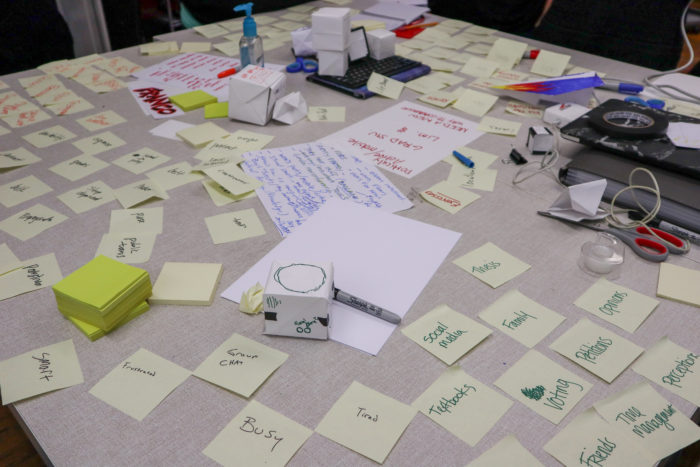While teaching as an architecture professor, Bit Space founder Thomas Kearns recognized that there were certain attitudes and dispositions exhibited by the most successful students. The idea of what Bit Space should be, and how it should help our young students, grew from a need to instill an approach to life that would lead to more successful learners and all-around humans.
This collection of approaches for students and teachers can help to create the right attitudes and dispositions for success in the makerspace. Practicing these approaches can help develop creativity, an elusive quality to teach. You can think of creativity as a combination of having curiosity, having some abilities, and having some discipline. These approaches help create an environment where curiosity is encouraged, where skills can be gained, and offer good suggestions for discipline.
Opportunities not Problems
Looking at the world for opportunities to make it better tends to be a more positive approach than always looking for problems. Furthermore, being critical for critical sake is not as beneficial as using critique to identify opportunities over problems. Rather than prompting students with “design problems,” we encourage our students and the teachers we work with to face design opportunistically. By starting the conversation with “what are the opportunities,” and “not what are the problems,” we can hopefully carry that positivity into our design practice.
Have Fun
If you’re having fun doing something, you are far more likely to want to work on it, to work on it for longer hours, and maybe even to look forward to coming back to it. Find a way to make your projects fun. Find fun in the work you do.

Must Make Many
We totally get it. The idea of doing things more than once is usually not considered ideal. However, finding pleasure in making multiple versions of what you might think of as “the same thing” is key to becoming a good designer and strong maker. Good design is always a result of many iterations.
Process Over Product
“Process over product” means refocusing your goals. Instead of looking at your design work as having a single final product as an outcome, see it as a series of discoveries about the things you make. Each mistake or victory informs your next attempt, leading to better and better versions each time. It’s a designer’s version of “success is a journey, not a destination.”

“Failure” is OK
Failure is instructive: you learn from it. Failure drives the iterative cycle. You do something and it either works or it doesn’t. Or maybe it works but not the way you thought it would. In any case, you’ve learned how to make it work better or you get other ideas for changes and improvements. Failure is where “a-ha!” moments live.
Failure isn’t easy, though, and we’re conditioned to avoid it or to hide our mistakes. If you’re going to embrace failure as learning, you need to establish the classroom as a safe space and foster a classroom culture where failure is accepted and even celebrated. Frame failure as learning and employ practices where students can reflect on failure and have opportunities to implement their new learnings.
Don’t fix student work. Don’t do the work for them.
If you accept the mindset that failure is acceptable, then you have to let it happen. Struggle and persistence are valuable and are how students develop real understanding.
If you see a student wrestling with a challenge, offer advice but let them do it themselves (unless what they’re doing is unsafe or what they need to do is legitimately too difficult for them to do). It may take them longer, but it’s better for them to do it rather than watch you do it.
Cult of Done
The creator of the MakerBot desktop 3D printer, Bre Pettis, and artist Kio Stark have published their manifesto for getting work done. The Cult of Done Manifesto establishes a strong approach which echos our sentiments and expands notions of completion, an important yet elusive state in design and development projects.
Tenets of Good Open Source Development
Eric Raymond, in his important essay “the Cathedral and the Bazaar” defines his tenets for good open source development practice. A few are written specifically to coders (“Every good work of software starts by scratching a developer’s personal itch,” and, “Treating your users as co-developers is your least-hassle route to rapid code improvement and effective debugging.”), but the essence can be easily applied to any kind of making project.

